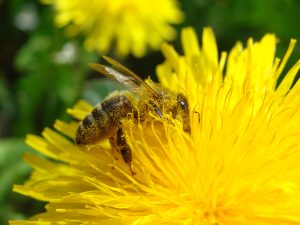4.1 Coevolution of Native Species
Non-native species, also known as exotic or introduced species, are those that have been brought to a new area from another part of the world. They are often spread by human activities, either intentionally or accidentally. Most non-native species peacefully coexist with the native plants and animals, but since they did not evolve in the region, they may not have the same level of connection to other species within the ecosystem.
Native species have co-evolved, meaning they have developed and adapted in response to each other’s presence. This co-evolution results in intricate relationships that are important in maintaining balanced ecosystems.
Let’s consider a couple of examples of coevolution:
Native Plants and Herbivores
Co-evolution happens frequently with plants and the organisms that eat them, called herbivores. An evolutionary change in the structure of a plant will affect the structure of an herbivore that eats the plant, which in turn affects the evolution of the plant, which affects the evolution of the herbivore… and the cycle continues.
Monarch caterpillars feed exclusively on milkweed because of their co-evolution. As a defence from getting eaten, milkweed evolved toxins called cardenolides that, when ingested, cause organisms to vomit and even lead to cardiac arrest. In turn, monarch caterpillars evolved to resist these toxins. Monarchs even incorporate the toxins into their own bodies, making them poisonous and protecting them from predation (Vernimmen, 2019).
Plants and Pollinators

Co-evolution leads to relationships between plants and pollinators where the morphology of the pollinator depends on the size and shape of the flower it pollinates, and vice versa.
For example, the common blue violet has evolved a flower shape and colour that promotes pollination by bees. Bees can see ultraviolet light, a spectrum invisible to humans. Violets have ultraviolet patterns that guide bees to the nectar and pollen. These patterns can form “nectar guides,” which are like runway markings directing bees to the center of the flower where the reproductive structures are located. In turn, some bees have evolved strong, long tongues that allow them to access nectar deep within the violet’s flowers. This coevolution has caused a mutualistic relationship where both species benefit. The common blue violets get fertilized, leading to higher seed production. And the bees receive a reliable source of nectar and pollen.
A Closer Look
Many pollinators are generalists, which will pollinate many different types of plants. Some pollinators have evolved to become specialists. Specialist pollinators have closer, often exclusive relationships with particular plant species.
The Violet Miner (Andrena violae) is a species of solitary bee that only pollinates violets. These bees have evolved long tongues that can reach the nectar hidden deep within the violet flowers. Their foraging behaviour is also closely timed with the flowering period of violets. The high degree of specialization in this relationship means that both the bees and the violets are closely dependent on each other. The bees rely on the violets for nectar, while the violets depend on the bees for effective pollination.


